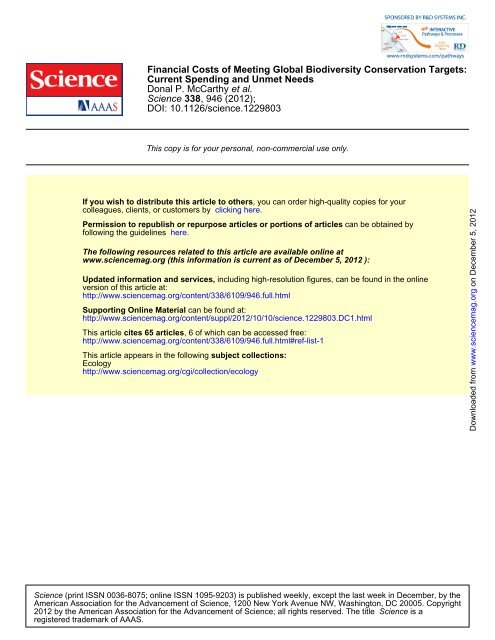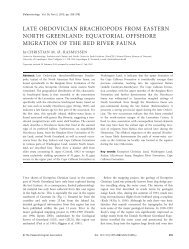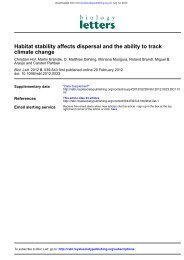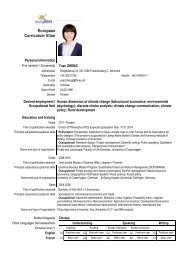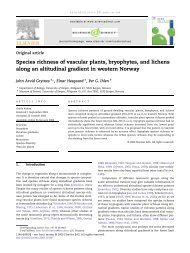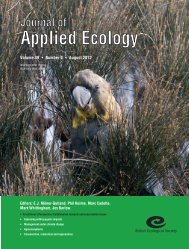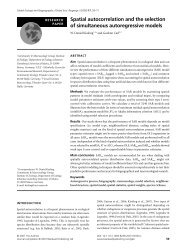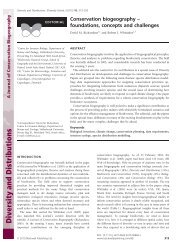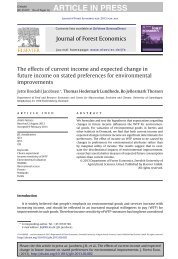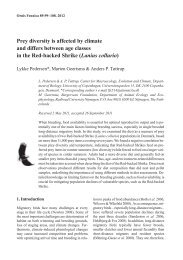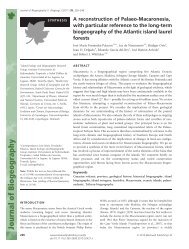DOI: 10.1126/science.1229803 , 946 (2012); 338 Science et al ...
DOI: 10.1126/science.1229803 , 946 (2012); 338 Science et al ...
DOI: 10.1126/science.1229803 , 946 (2012); 338 Science et al ...
Create successful ePaper yourself
Turn your PDF publications into a flip-book with our unique Google optimized e-Paper software.
Financi<strong>al</strong> Costs of Me<strong>et</strong>ing Glob<strong>al</strong> Biodiversity Conservation Targ<strong>et</strong>s:<br />
Current Spending and Unm<strong>et</strong> Needs<br />
Don<strong>al</strong> P. McCarthy <strong>et</strong> <strong>al</strong>.<br />
<strong>Science</strong> <strong>338</strong>, <strong>946</strong> (<strong>2012</strong>);<br />
<strong>DOI</strong>: <strong>10.1126</strong>/<strong>science.1229803</strong><br />
This copy is for your person<strong>al</strong>, non-commerci<strong>al</strong> use only.<br />
If you wish to distribute this article to others, you can order high-qu<strong>al</strong>ity copies for your<br />
colleagues, clients, or customers by clicking here.<br />
Permission to republish or repurpose articles or portions of articles can be obtained by<br />
following the guidelines here.<br />
The following resources related to this article are available online at<br />
www.sciencemag.org (this information is current as of December 5, <strong>2012</strong> ):<br />
Updated information and services, including high-resolution figures, can be found in the online<br />
version of this article at:<br />
http://www.sciencemag.org/content/<strong>338</strong>/6109/<strong>946</strong>.full.html<br />
Supporting Online Materi<strong>al</strong> can be found at:<br />
http://www.sciencemag.org/content/suppl/<strong>2012</strong>/10/10/<strong>science.1229803</strong>.DC1.html<br />
This article cites 65 articles, 6 of which can be accessed free:<br />
http://www.sciencemag.org/content/<strong>338</strong>/6109/<strong>946</strong>.full.html#ref-list-1<br />
This article appears in the following subject collections:<br />
Ecology<br />
http://www.sciencemag.org/cgi/collection/ecology<br />
Downloaded from www.sciencemag.org on December 5, <strong>2012</strong><br />
<strong>Science</strong> (print ISSN 0036-8075; online ISSN 1095-9203) is published weekly, except the last week in December, by the<br />
American Association for the Advancement of <strong>Science</strong>, 1200 New York Avenue NW, Washington, DC 20005. Copyright<br />
<strong>2012</strong> by the American Association for the Advancement of <strong>Science</strong>; <strong>al</strong>l rights reserved. The title <strong>Science</strong> is a<br />
registered trademark of AAAS.
REPORTS<br />
38. G. H. Odell, F. Cowan, J. Field Archaeol. 13, 195 (1986).<br />
39. J. Parg<strong>et</strong>er, S. Afr. Archaeol. Bull. 62, 147 (2007).<br />
40. A. Yaroshevich, D. Kaufman, D. Nuzhnyy, O. Bar-Yosef,<br />
M. Weinstein-Evron, J. Archaeol. Sci. 37, 368 (2010).<br />
41. K. Sano, Quartär 56, 67 (2009).<br />
Acknowledgments: This research was supported by a Soci<strong>al</strong><br />
<strong>Science</strong>s and Humanities Research Council Joseph-Armand<br />
Bombardier Canada Graduate Scholarship and funding from<br />
the University of Toronto to J.W. The McGregor Museum and<br />
the South African Heritage Resources Agency permitted<br />
temporary export of the points for study. Fieldwork at KP1<br />
was supported by funding from the Soci<strong>al</strong> <strong>Science</strong>s and<br />
Humanities Research Council of Canada to M.C. B.J.S. and<br />
K.S.B. were funded by grants from NSF (BCS-0524087 and<br />
BCS-1138073) and the Hyde Family Foundation to C. Marean<br />
and from the Institute of Human Origins at Arizona State<br />
University. We thank D. Morris, N. Porat, L. K. Horwitz,<br />
C. Marean, and P. Beaumont. Data are tabulated in the online<br />
supplementary materi<strong>al</strong>s.<br />
Supplementary Materi<strong>al</strong>s<br />
www.sciencemag.org/cgi/content/full/<strong>338</strong>/6109/942/DC1<br />
Materi<strong>al</strong>s and M<strong>et</strong>hods<br />
Figs. S1 to S8<br />
Tables S1 to S5<br />
References (42–53)<br />
18 July <strong>2012</strong>; accepted 4 October <strong>2012</strong><br />
<strong>10.1126</strong>/science.1227608<br />
Financi<strong>al</strong> Costs of Me<strong>et</strong>ing Glob<strong>al</strong><br />
Biodiversity Conservation Targ<strong>et</strong>s:<br />
Current Spending and Unm<strong>et</strong> Needs<br />
Don<strong>al</strong> P. McCarthy, 1,2 Paul F. Don<strong>al</strong>d, 2 Jörn P. W. Scharlemann, 3,4 Graeme M. Buchanan, 2<br />
Andrew B<strong>al</strong>mford, 5 Jonathan M. H. Green, 5,6 Leon A. Bennun, 1 Neil D. Burgess, 5,7,8<br />
Lincoln D. C. Fishpool, 1 Stephen T. Garn<strong>et</strong>t, 9 David L. Leonard, 10 * Richard F. M<strong>al</strong>oney, 11<br />
Paul Morling, 2 H. Martin Schaefer, 12 Andy Symes, 1 David A. Wiedenfeld, 13 Stuart H. M. Butchart 1 †<br />
World governments have committed to h<strong>al</strong>ting human-induced extinctions and safeguarding<br />
important sites for biodiversity by 2020, but the financi<strong>al</strong> costs of me<strong>et</strong>ing these targ<strong>et</strong>s are<br />
largely unknown. We estimate the cost of reducing the extinction risk of <strong>al</strong>l glob<strong>al</strong>ly threatened<br />
bird species (by ≥1 Internation<strong>al</strong> Union for Conservation of Nature Red List category) to be<br />
U.S. $0.875 to $1.23 billion annu<strong>al</strong>ly over the next decade, of which 12% is currently funded.<br />
Incorporating threatened nonavian species increases this tot<strong>al</strong> to U.S. $3.41 to $4.76 billion<br />
annu<strong>al</strong>ly. We estimate that protecting and effectively managing <strong>al</strong>l terrestri<strong>al</strong> sites of glob<strong>al</strong><br />
avian conservation significance (11,731 Important Bird Areas) would cost U.S. $65.1 billion<br />
annu<strong>al</strong>ly. Adding sites for other taxa increases this to U.S. $76.1 billion annu<strong>al</strong>ly. Me<strong>et</strong>ing<br />
these targ<strong>et</strong>s will require conservation funding to increase by at least an order of magnitude.<br />
After the failure of previous glob<strong>al</strong> commitments<br />
to reduce the rate of loss of<br />
biodiversity (1), parties to the Convention<br />
on Biologic<strong>al</strong> Diversity (CBD) recently adopted<br />
a new strategic plan, including 20 targ<strong>et</strong>s to be<br />
m<strong>et</strong> by 2020 (2). Negotiations on financing the<br />
plan are not y<strong>et</strong> resolved, partly for lack of information<br />
on financi<strong>al</strong> costs. We used data on<br />
birds, the best known class of organisms, to assess<br />
the financi<strong>al</strong> costs of me<strong>et</strong>ing two of the targ<strong>et</strong>s<br />
1 BirdLife Internation<strong>al</strong>, Wellbrook Court, Cambridge CB3 0NA,<br />
UK. 2 RSPB, The Lodge, Sandy, Bedfordshire, SG19 2DL, UK.<br />
3 United Nations Environment Programme World Conservation<br />
Monitoring Centre, 219 Huntingdon Road, Cambridge CB3<br />
0DL, UK. 4 School of Life <strong>Science</strong>s, University of Sussex, F<strong>al</strong>mer,<br />
Brighton, BN1 9QG, UK. 5 Department of Zoology, University of<br />
Cambridge, Downing Stre<strong>et</strong>, Cambridge CB2 3EJ, UK. 6 Woodrow<br />
Wilson School of Public and Internation<strong>al</strong> Affairs, Princ<strong>et</strong>on<br />
University,Princ<strong>et</strong>on,NJ08544,USA. 7 Center for Macroecology,<br />
Evolution and Climate, Department of Biology, University<br />
of Copenhagen, DK-1165 Copenhagen, Denmark. 8 Conservation<br />
<strong>Science</strong> Program, World Wildlife Fund, Washington, DC<br />
20090, USA. 9 Research Institute for the Environment and Livelihoods,<br />
Charles Darwin University, Northern Territory 0909,<br />
Austr<strong>al</strong>ia. 10 Pacific Cooperative Studies Unit (University of Hawai‘i<br />
at Manoa), Hawaii Division of Forestry and Wildlife, Honolulu,<br />
HI 96822, USA. 11 <strong>Science</strong> and Technic<strong>al</strong> Group, Department of<br />
Conservation, Christchurch, New Ze<strong>al</strong>and. 12 University of Freiburg,<br />
Faculty of Biology, Hauptstrasse 1, D-79104 Freiburg, Germany.<br />
13 12 Fishback Court, Warrenton, VA 20186, USA.<br />
*Present address: U.S. Fish and Wildlife Service, Portland,<br />
OR 97266, USA.<br />
†To whom correspondence should be addressed. E-mail:<br />
stuart.butchart@birdlife.org<br />
relating to conserving species and sites: (i) preventing<br />
the extinction of known threatened species<br />
and improving and sustaining their conservation<br />
status (Targ<strong>et</strong> 12) and (ii) effectively managing<br />
and expanding protected areas to cover 17% of<br />
terrestri<strong>al</strong> and inland water areas (and 10% of<br />
coast<strong>al</strong> and marine areas), “especi<strong>al</strong>ly areas of particular<br />
importance for biodiversity” (Targ<strong>et</strong> 11)<br />
(2). These two targ<strong>et</strong>s <strong>al</strong>ign closely with the existing<br />
focus of much of the conservation sector;<br />
they are <strong>al</strong>so among the most immediately urgent,<br />
involving discr<strong>et</strong>e actions amenable to costing.<br />
To assess the costs of species conservation,<br />
we sampled 211 glob<strong>al</strong>ly threatened bird species<br />
[19% of <strong>al</strong>l threatened bird species on the Internation<strong>al</strong><br />
Union for Conservation of Nature<br />
(IUCN) Red List (3)]. We asked experts on each<br />
species to estimate (i) recent expenditure on conservation<br />
actions, and (ii) a range of costs for<br />
conservation actions needed to achieve the minimum<br />
improvement in status necessary to reclassify<br />
(“downlist”) each species to the next lowest<br />
category of extinction risk on the Red List (e.g.,<br />
from Critic<strong>al</strong>ly Endangered to Endangered). We<br />
modeled midrange cost estimates as a function of<br />
breeding distribution extent, degree of forest dependence,<br />
mean Gross Domestic Product per km 2<br />
of breeding range states, and mean Purchasing<br />
Power Parity of breeding range states, and we<br />
used this model to estimate costs for <strong>al</strong>l other<br />
glob<strong>al</strong>ly threatened bird species (4) (fig. S1).<br />
The median modeled annu<strong>al</strong> cost per species<br />
for conservation actions required to achieve downlisting<br />
within 10 years was U.S. $0.848 million<br />
(range: U.S. $0.0387 to $8.96 million; <strong>al</strong>l v<strong>al</strong>ues<br />
adjusted to <strong>2012</strong> U.S. $) (Fig. 1A and table S1).<br />
This compares with a median of U.S. $0.219 million<br />
annu<strong>al</strong>ly [range: U.S. $0.001 to $4.82 million,<br />
standardized to the same 10-year period and adjusted<br />
for inflation (4)] for 25 threatened species<br />
that were successfully downlisted during 1988–<br />
2008 because of genuine improvements in their<br />
status (i.e., directly resulting from conservation<br />
interventions) (5) (table S2). Costs for <strong>al</strong>l but one<br />
of these species fell within the range of our sample<br />
of estimated costs (Fig. 1A), <strong>al</strong>though the<br />
median was significantly lower [an<strong>al</strong>ysis of variance<br />
(ANOVA) of natur<strong>al</strong> log–transformed v<strong>al</strong>ues:<br />
F 1, 259 =7.4,P
REPORTS<br />
possibly even increased) funding to maintain any<br />
improvement in their status beyond 2020, particularly<br />
given the likely intensification of existing<br />
threats, the increasing impacts associated with<br />
climate change, and the emergence of potenti<strong>al</strong><br />
new threats (9).<br />
The median annu<strong>al</strong> expenditure within the last<br />
decade for the 211 species in our sample was<br />
U.S. $0.065 million (range: $0 to $15.2 million),<br />
with the majority of resources spent on just a few<br />
species, which reflects a common pattern documented<br />
at nation<strong>al</strong> levels (10–12). This covered a<br />
median of 12% of the estimated required annu<strong>al</strong><br />
Number of species<br />
60<br />
50<br />
40<br />
30<br />
20<br />
10<br />
0<br />
A<br />
expenditure per species. Recent funding was adequate<br />
(>90% of estimated need) for only 3% of<br />
species (n = 7), and
REPORTS<br />
sites across 50 countries (table S6). Extrapolation<br />
suggests that the tot<strong>al</strong> cost worldwide would be<br />
U.S. $7.18 billion annu<strong>al</strong>ly for currently protected<br />
IBAs, of which U.S. $1.58 billion (22%) is<br />
required in lower-income countries.<br />
We assessed the costs of expanding protected<br />
area n<strong>et</strong>works to cover <strong>al</strong>l unprotected and parti<strong>al</strong>ly<br />
protected IBAs using spati<strong>al</strong>ly explicit<br />
agricultur<strong>al</strong> land v<strong>al</strong>ues (gross economic rents)<br />
from Naidoo and Iwamura (17) as a proxy for<br />
purchase or compensation costs (4). This produced<br />
a tot<strong>al</strong> cost of U.S. $50.7 billion annu<strong>al</strong>ly (U.S.<br />
$15.9 billion, 31%, in lower-income countries),<br />
which is comparable to previous estimates of<br />
protected area expansion costs in developing<br />
countries (18). Applying our management cost<br />
model (see above) to these sites yields an estimate<br />
of U.S. $7.11 billion annu<strong>al</strong>ly, resulting<br />
in a tot<strong>al</strong> figure of U.S. $57.8 billion required<br />
annu<strong>al</strong>ly for protecting and effectively managing<br />
<strong>al</strong>l IBAs.<br />
Glob<strong>al</strong>ly important sites have <strong>al</strong>so been systematic<strong>al</strong>ly<br />
identified for mamm<strong>al</strong>s; amphibians;<br />
and certain reptile, fish, plant and invertebrate<br />
groups in 12 countries (19, 20). Of these sites,<br />
71% <strong>al</strong>ready qu<strong>al</strong>ify as IBAs and cover 80% of<br />
the tot<strong>al</strong> area (14). Assuming the are<strong>al</strong> relation<br />
holds worldwide and that such sites have a level<br />
of protection similar to that of IBAs, we estimate<br />
that protecting and effectively managing a more<br />
taxonomic<strong>al</strong>ly comprehensive glob<strong>al</strong> n<strong>et</strong>work of<br />
terrestri<strong>al</strong> sites would cost U.S. $76.1 billion annu<strong>al</strong>ly<br />
(U.S. $22.4 billion annu<strong>al</strong>ly, 29% in lowerincome<br />
countries) (Fig. 2).<br />
We estimate that current annu<strong>al</strong> expenditure<br />
on managing IBAs that are <strong>al</strong>ready under some<br />
form of protection f<strong>al</strong>ls short of requirements by<br />
U.S. $1.09 billion annu<strong>al</strong>ly in lower-income countries<br />
(31% of needs covered) and by $2.82 billion<br />
annu<strong>al</strong>ly in higher-income countries [50% of<br />
needs covered, <strong>al</strong>though this figure is based on<br />
more limited data (4)]. Management of an expanded<br />
protected area n<strong>et</strong>work covering <strong>al</strong>l currently<br />
unprotected or parti<strong>al</strong>ly protected IBAs<br />
increases the estimated shortf<strong>al</strong>l to $2.78 billion<br />
for lower-income countries and $8.24 billion for<br />
higher-income countries.<br />
Downloaded from www.sciencemag.org on December 5, <strong>2012</strong><br />
Fig. 2. Current expenditure and tot<strong>al</strong> required for<br />
conserving 1115 threatened bird species and safeguarding<br />
11,731 important sites for birds in lowerand<br />
higher-income countries (black and gray bars,<br />
respectively). Bars for species show costs accounting<br />
for sharing b<strong>et</strong>ween species, with vertic<strong>al</strong> lines<br />
indicating costs excluding sharing. Bars for sites<br />
indicate management costs, with the vertic<strong>al</strong> line<br />
for unprotected sites showing acquisition costs.<br />
Fig. 3. Geographic patterns in the annu<strong>al</strong> cost for conservation actions (U.S. $ km −2 ) for 1097 glob<strong>al</strong>ly<br />
threatened bird species (A) assuming that actions for each species are independent and (B)assumingcost<br />
sharing; (C) number of species km −2 ,and(D) distribution of IBAs (points; red indicating those for which<br />
management-cost data were included in the model) and lower-income countries (blue shading). Costs and<br />
number of species are divided into quantiles; areas with no glob<strong>al</strong>ly threatened bird species present shown<br />
in gray in (A to C); Behrmann equ<strong>al</strong>-area projection. Distribution maps for 18 glob<strong>al</strong>ly threatened species<br />
are not available.<br />
948<br />
16 NOVEMBER <strong>2012</strong> VOL <strong>338</strong> SCIENCE www.sciencemag.org
REPORTS<br />
A proportion of the costs would be shared<br />
b<strong>et</strong>ween the species and site targ<strong>et</strong>s considered<br />
here. Establishing protection and managing sites<br />
made up 50 to 55% of the tot<strong>al</strong> costs for sampled<br />
bird species. Discounting this proportion from<br />
the tot<strong>al</strong> cost of species conservation across <strong>al</strong>l<br />
taxa, a combined cost needed to me<strong>et</strong> both species<br />
and site CBD targ<strong>et</strong>s may be in the order of<br />
U.S. $78.1 billion annu<strong>al</strong>ly (Fig. 2). It is <strong>al</strong>so<br />
highly likely that actions to me<strong>et</strong> these two targ<strong>et</strong>s<br />
will contribute to other targ<strong>et</strong>s in the CBD<br />
strategic plan, which are critic<strong>al</strong> to delivering sustainable<br />
development and the safeguarding of<br />
glob<strong>al</strong> biodiversity in the long term (4).<br />
Even with increased investment, careful prioritization<br />
will continue to be necessary to inform<br />
decisions about which areas to protect and which<br />
actions to undertake for species, e.g., using approaches<br />
that optimize r<strong>et</strong>urns on investment,<br />
given fixed budg<strong>et</strong>s and defined objectives, for<br />
sites (21), species (7, 8), and management actions<br />
(22). Our finding that species facing higher categories<br />
of extinction risk require less investment<br />
for downlisting than do those in lower categories<br />
suggests that in many cases such an<strong>al</strong>yses will<br />
prioritize actions for the most-threatened species<br />
first. We <strong>al</strong>so note that there is considerable glob<strong>al</strong><br />
spati<strong>al</strong> variation in costs and the number of<br />
threatened species per unit area (Fig. 3). Although<br />
the shortf<strong>al</strong>ls in higher-income countries are substanti<strong>al</strong>,<br />
the greatest gains per dollar will be in<br />
lower-income countries (23).<br />
Despite the limitations of the available data,<br />
the shortf<strong>al</strong>ls we have identified clearly highlight<br />
the need to increase investment in biodiversity<br />
conservation by at least an order of magnitude,<br />
especi<strong>al</strong>ly given the sm<strong>al</strong>l, but growing, body of<br />
evidence linking spending and effectiveness<br />
(24, 25). Nevertheless, the tot<strong>al</strong> costs are sm<strong>al</strong>l<br />
relative to the v<strong>al</strong>ue of the potenti<strong>al</strong> goods and services<br />
that biodiversity provides (26), e.g., equiv<strong>al</strong>ent<br />
to 1 to 4% of the estimated n<strong>et</strong> v<strong>al</strong>ue of<br />
ecosystem services that are lost per year [estimated<br />
at $2 to $6.6 trillion (27–29)]. More prosaic<strong>al</strong>ly,<br />
the tot<strong>al</strong> required is less than 20% of annu<strong>al</strong><br />
glob<strong>al</strong> consumer spending on soft drinks (30).<br />
These results should inform discussions among<br />
governments on the magnitude of the financing<br />
needs for implementing the CBD Strategic Plan<br />
for Biodiversity 2011–2020. A particular ch<strong>al</strong>lenge<br />
will be how to address the current mismatch b<strong>et</strong>ween<br />
the greater resources available in richer<br />
countries and the higher potenti<strong>al</strong> conservation<br />
gains in financi<strong>al</strong>ly poor, biodiversity-rich countries<br />
(31, 32). Resolving the ongoing conservation<br />
funding crisis is urgent; it is likely that,<br />
the longer that investments in conservation are<br />
delayed, the more the costs will grow (23, 33),<br />
and the greater will be the difficulty of successfully<br />
me<strong>et</strong>ing the targ<strong>et</strong>s (6, 34).<br />
References and Notes<br />
1. S. H. M. Butchart <strong>et</strong> <strong>al</strong>., <strong>Science</strong> 328, 1164 (2010).<br />
2. CBD, Conference of the Parties Decision X/2: Strategic<br />
plan for biodiversity 2011–2020; www.cbd.int/decision/<br />
cop/?id=12268 (2011).<br />
3. BirdLife Internation<strong>al</strong>, IUCN Red List for birds;<br />
www.birdlife.org (2011).<br />
4. Further information is available as supplementary<br />
materi<strong>al</strong>s on <strong>Science</strong> Online.<br />
5. S. H. M. Butchart <strong>et</strong> <strong>al</strong>., PLoS Biol. 2, e383 (2004).<br />
6. P. F. Don<strong>al</strong>d, N. J. Collar, S. J. Marsden, D. J. Pain,<br />
Facing Extinction: The World's Rarest Birds and the Race<br />
to Save Them (Poyser, London, 2010).<br />
7. L. N. Joseph, R. F. M<strong>al</strong>oney, H. P. Possingham,<br />
Conserv. Biol. 23, 328 (2009).<br />
8. M. A. McCarthy, C. J. Thompson, S. T. Garn<strong>et</strong>t, J. Appl. Ecol.<br />
45, 1428 (2008).<br />
9. H. M. Pereira <strong>et</strong> <strong>al</strong>., <strong>Science</strong> 330, 1496 (2010).<br />
10. H. F. Laycock, D. Moran, J. C. R. Smart, D. G. Raffaelli,<br />
P. C. L. White, Ecol. Econ. 70, 1789 (2011).<br />
11. T. D. M<strong>al</strong>e, M. J. Bean, Ecol. L<strong>et</strong>t. 8, 986 (2005).<br />
12. D. L. Leonard Jr., Biol. Conserv. 141, 2054 (2008).<br />
13. IUCN, IUCN Red List of Threatened Species, Summary<br />
Statistics (<strong>2012</strong>); www.iucnredlist.org/documents/<br />
summarystatistics/<strong>2012</strong>_1_RL_Stats_Table_1.pdf.<br />
14. S. H. M. Butchart <strong>et</strong> <strong>al</strong>., PLoS ONE 7, e32529 (<strong>2012</strong>).<br />
15. BirdLife Internation<strong>al</strong>, State of the World's Birds 2004:<br />
Indicators for Our Changing World (BirdLife<br />
Internation<strong>al</strong>, Cambridge, UK, 2004).<br />
16. N. Dudley, Guidelines for Appling Protected Areas<br />
Management Categories (IUCN, Gland, Switzerland,<br />
2008).<br />
17. R. Naidoo, T. Iwamura, Biol. Conserv. 140, 40 (2007).<br />
18. A. G. Bruner, R. E. Gullison, A. B<strong>al</strong>mford, Bioscience 54,<br />
1119 (2004).<br />
19. G. Eken <strong>et</strong> <strong>al</strong>., Bioscience 54, 1110 (2004).<br />
20. M. N. Foster <strong>et</strong> <strong>al</strong>., J. Threat. Taxa 4, 2733 (<strong>2012</strong>).<br />
21. J. E. M. Watson <strong>et</strong> <strong>al</strong>., Conserv. Biol. 25, 324 (2011).<br />
22. J. Carwardine <strong>et</strong> <strong>al</strong>., Conserv. L<strong>et</strong>t. 5, 196 (<strong>2012</strong>).<br />
23. A. B<strong>al</strong>mford, K. J. Gaston, S. Blyth, A. James, V. Kapos,<br />
Proc. Natl. Acad. Sci. U.S.A. 100, 1046 (2003).<br />
24. K. E. Gibbs, D. J. Currie, PLoS ONE 7, e35730 (<strong>2012</strong>).<br />
25. N. Leader-Williams, S. Albon, Nature 336, 533 (1988).<br />
26. R. Costanza <strong>et</strong> <strong>al</strong>., Nature 387, 253 (1997).<br />
27. A. B<strong>al</strong>mford <strong>et</strong> <strong>al</strong>., <strong>Science</strong> 297, 950 (2002).<br />
28. UN Environment Programme–Financi<strong>al</strong> Initiative and<br />
Principles for Responsible Investment, Univers<strong>al</strong><br />
Ownership: Why Environment<strong>al</strong> Extern<strong>al</strong>ities Matter to<br />
Institution<strong>al</strong> Investors (PRI and UNEP-FI, 2010).<br />
29. The Economics of Ecosystems and Biodiversity, The<br />
Economics of Ecosystems and Biodiversity for Nation<strong>al</strong><br />
and Internation<strong>al</strong> Policy Making (2009); www.teebweb.org.<br />
30. RTS Resource Ltd., Soft Drinks Fact She<strong>et</strong> (<strong>2012</strong>);<br />
www.rts-resource.com/Blog/Free-Fact-She<strong>et</strong>s/He<strong>al</strong>th-<br />
driving-growth-in-$469bn-soft-drinks-mark<strong>et</strong>,-<br />
carbonates-in-decline/<strong>2012</strong>/6/26.aspx.<br />
31. A. B<strong>al</strong>mford, T. Whitten, Oryx 37, 238 (2003).<br />
32. M. L. McKinney, Conserv. Biol. 16, 539 (2002).<br />
33. M. Drechsler, F. V. Eppink, F. Wätzold, Biodivers. Conserv.<br />
20, 1045 (2011).<br />
34. T. G. Martin <strong>et</strong> <strong>al</strong>., Conserv. L<strong>et</strong>t. 5, 274 (<strong>2012</strong>).<br />
Acknowledgments: This work was supported by the<br />
Cambridge Conservation Initiative Collaborative Fund for<br />
Conservation and by Arcadia. For helpful comments and<br />
assistance, we thank A. Bruner, R. Naidoo, M. Ausden,<br />
L. Don<strong>al</strong>dson, and many other individu<strong>al</strong>s who kindly<br />
provided estimates of costs of species conservation or<br />
site management; a full list is given in the supplementary<br />
materi<strong>al</strong>s. All data sources are listed in the supplementary<br />
materi<strong>al</strong>s.<br />
Supplementary Materi<strong>al</strong>s<br />
www.sciencemag.org/cgi/content/full/<strong>science.1229803</strong>/DC1<br />
Materi<strong>al</strong>s and M<strong>et</strong>hods<br />
Supplementary Text<br />
Figs. S1 to S2<br />
Tables S1 to S6<br />
References (35–126)<br />
6 September <strong>2012</strong>; accepted 4 October <strong>2012</strong><br />
Published online 11 October <strong>2012</strong>;<br />
<strong>10.1126</strong>/<strong>science.1229803</strong><br />
Pathologic<strong>al</strong> a-Synuclein Transmission<br />
Initiates Parkinson-like Neurodegeneration<br />
in Nontransgenic Mice<br />
Kelvin C. Luk, Victoria Kehm, Jenna Carroll, Bin Zhang, Patrick O’Brien,<br />
John Q. Trojanowski, Virginia M.-Y. Lee*<br />
Parkinson’s disease is characterized by abundant a-synuclein (a-Syn) neuron<strong>al</strong> inclusions, known<br />
as Lewy bodies and Lewy neurites, and the massive loss of midbrain dopamine neurons. However, a<br />
cause-and-effect relationship b<strong>et</strong>ween Lewy inclusion formation and neurodegeneration remains<br />
unclear. Here, we found that in wild-type nontransgenic mice, a single intrastriat<strong>al</strong> inoculation of<br />
synth<strong>et</strong>ic a-Syn fibrils led to the cell-to-cell transmission of pathologic a-Syn and Parkinson’s-like<br />
Lewy pathology in anatomic<strong>al</strong>ly interconnected regions. Lewy pathology accumulation resulted in<br />
progressivelossofdopamineneuronsinthesubstantia nigra pars compacta, but not in the adjacent<br />
ventr<strong>al</strong> tegment<strong>al</strong> area, and was accompanied by reduced dopamine levels culminating in motor<br />
deficits. This recapitulation of a neurodegenerative cascade thus establishes a mechanistic link b<strong>et</strong>ween<br />
transmission of pathologic a-Syn and the cardin<strong>al</strong> features of Parkinson’s disease.<br />
Parkinson’s disease (PD) is a multisystem<br />
neurodegenerative disorder characterized<br />
by two major disease processes: the accumulation<br />
of intraneuron<strong>al</strong> Lewy bodies/Lewy<br />
neurites (LBs/LNs) containing misfolded fibrillar<br />
a-synuclein (a-Syn), and the selective degeneration<br />
of midbrain dopamine (DA) neurons in the<br />
substantia nigra pars compacta (SNpc) leading to<br />
bradykinesia, tremor, and postur<strong>al</strong> instability (1).<br />
The <strong>et</strong>iology of these processes remains unclear,<br />
<strong>al</strong>though in famili<strong>al</strong> PD, autosom<strong>al</strong> dominant<br />
a-Syn gene mutations or amplifications directly<br />
Department of Pathology and Laboratory Medicine, Institute on<br />
Aging and Center for Neurodegenerative Disease Research,<br />
University of Pennsylvania Perelman School of Medicine,<br />
Philadelphia, PA 19104–4283, USA.<br />
*To whom correspondence should be addressed. E-mail:<br />
vmylee@upenn.edu (V.M.Y.L.).<br />
Downloaded from www.sciencemag.org on December 5, <strong>2012</strong><br />
www.sciencemag.org SCIENCE VOL <strong>338</strong> 16 NOVEMBER <strong>2012</strong> 949


